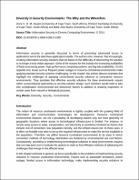| dc.contributor.author | Ssembatya, Richard | |
| dc.contributor.author | Kayem, Anne V. D. M. | |
| dc.contributor.author | Burke, Mark-John | |
| dc.date.accessioned | 2019-02-14T08:27:12Z | |
| dc.date.available | 2019-02-14T08:27:12Z | |
| dc.date.issued | 2014 | |
| dc.identifier.citation | Ssembatya, R.; Kayem, Anne V. D. M. & Burke, M. J., 2014. Diversity in Security Environments: The Why and the Wherefore. Uganda Martyrs University, Nkozi: Uganda Martyrs University. | en_US |
| dc.identifier.uri | http://hdl.handle.net/20.500.12280/1349 | |
| dc.description.abstract | Information security is generally discussed in terms of preventing adversarial access to applications and to the data these applications handle. The authors note, however, that increasingly, creating information security solutions that are based on the difficulty of discovering the solution is no longer a truly viable approach. Some of the reasons for this include the increasing availability of faster processing power, high-performance computing systems, and big data availability. On the opposite end, issues such as frequent power outages in resource-constrained environments make applying standard security schemes challenging. In this chapter, the authors discuss examples that highlight the challenges of applying conventional security solutions to constrained resource environments. They postulate that effective security solutions for these environments require rather unconventional approaches to security-solution design. Such solutions would need to take into consideration environmental and behavioral factors in addition to drawing inspiration in certain cases from natural or biological processes. | en_US |
| dc.language.iso | en | en_US |
| dc.publisher | Uganda Martyrs University | en_US |
| dc.subject | Diversity | en_US |
| dc.subject | Security | en_US |
| dc.subject | Environments | en_US |
| dc.title | Diversity in Security Environments: The Why and the Wherefore | en_US |
| dc.type | Article | en_US |


